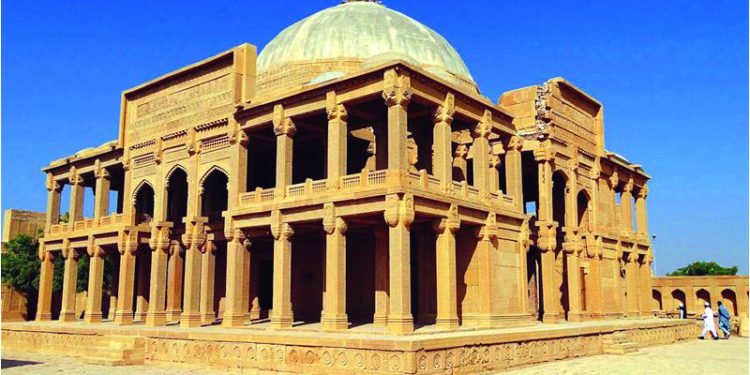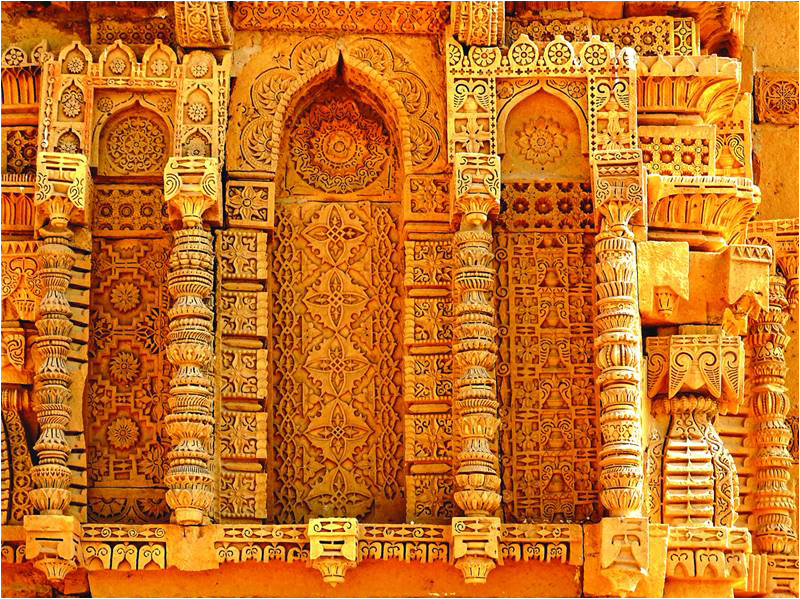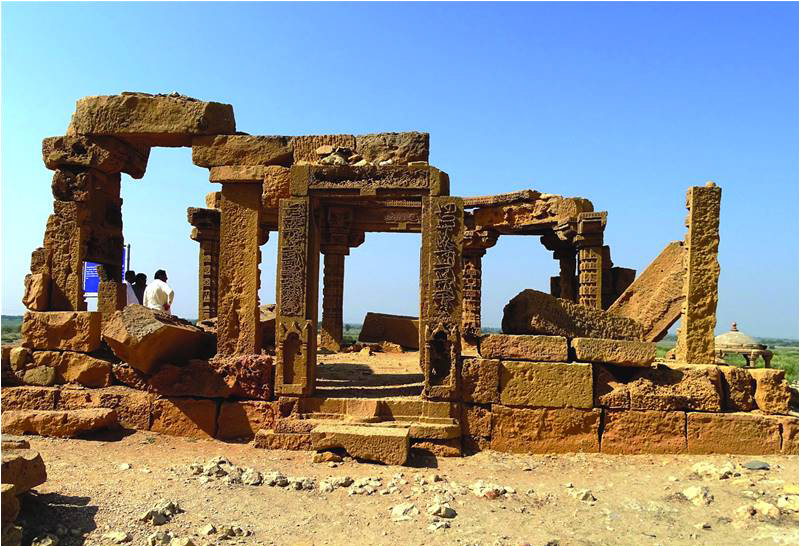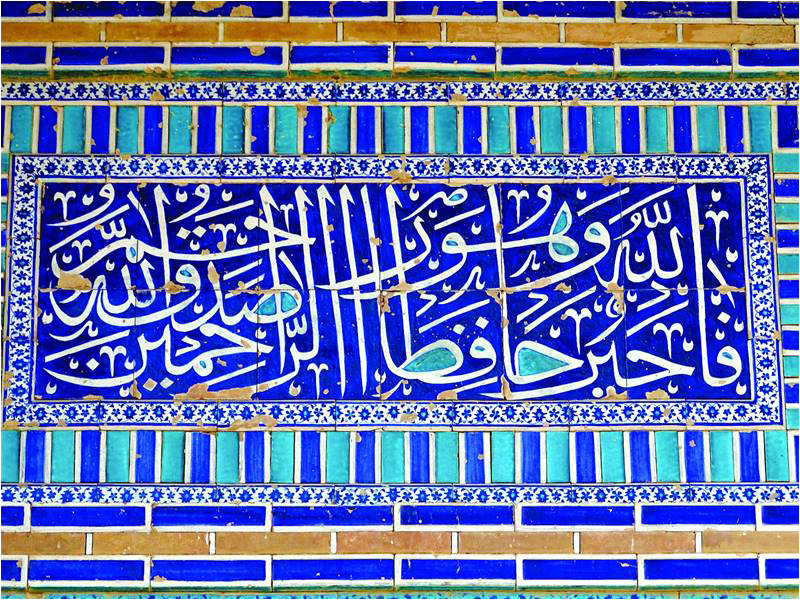
The most splendid structure belongs to Jam Nizamuddin alias Jam Nindo who was the longest serving Samma king of Sindh.
Makli merits more attention from the Culture, Tourism and Antiquities Department.
Zulfiqar Ali Kalhoro
Makli is one of the largest necropolises of the Islamic world – spread over 12 square kilometers containing the tombs and graves of kings, princes, queens, poets, religious scholars and others. The Samma (1351-1524) were the first rulers to erect monuments on Makli Hill, followed by the Arghuns (1524-1555), the Tarkhans (1555-1592) and the Kalhoras (1737-1773).
The most splendid structure belongs to Jam Nizamuddin alias Jam Nindo who was the longest serving Samma king of Sindh. The intricate carvings on the façade and mihrab of the tomb leave onlookers mulling over the mind-boggling designs that the Samma artisans crafted. These intricate carvings also reflect how skilled the master craftsmen were – being Sindhi artists of their era. The Samma cluster also includes the earliest canopies at Makli Hill, thus providing prototypes to later period of canopies erected by the Tarkhans.
Stone and brick-built tombs break the skylines of Makli, a necropolis which is named after a female saint whose grave is located west of the Jami mosque of the Samma period (1351-1524). But some Sindhi historians contest this and believe that due to abundance of graves of saints it was called “Makkah li” meaning “Makkah for me”. According to Professor Ahmad Hasan Dani’s book Thatta – Islamic Architecture, neighboring Makli Hill became the rendezvous of saints. Makli Hill attracted many mystics from the Islamic world who made their khanqahs (hermitages) there.

The Sammas, under whose reign Thatta became a flourishing city in Sindh, were the first master builders of Makli. They built tombs and hermitages for saints. Two of the earliest hermitages were those of Shaikh Hamad Jamali and Shaikh Isa Langoti. Both of these hermitages still dominate the landscape of Makli. The Samma artists excelled in intricate carvings which they made on the pillars of Chatris and on façade and mihrab of Jam Nindo’s tomb. It is presumed that the Samma rulers built tombs only on Makli Hill. But there are many tombs and stone-carved graves in Lower Sindh which are also believed to have been erected during their reign.
The meticulously carved façade of Jam Nindo’s tomb makes it one of the finest architectural marvels in tomb architecture in the Islamicate world
The crown jewel of Samma architecture is the tomb of Jam Nizamuddin alias Jam Nindo. Every inch of the structure was carefully carved. In fact, the meticulously carved façade of Jam Nindo’s tomb makes it one of the finest architectural marvels in tomb architecture in the Islamicate world. The triple mihrab assemblage with ornately carved blocks makes it an important example of Sindhi architecture. The tomb of Jam Nindo was source of inspiration for later tombs built on the Makli Hill in terms of designs and calligraphy. The tomb of Mian Mubarak Khan, the prime minister of Jam Nindo, was the first stone-tomb enclosure with masons’ marks carved on the mihrab. This provided a prototype to later stone- and brick-tomb enclosures erected by the Arghuns and the Tarkhans.
The stone tomb enclosure of Isa Khan I was highly influenced by the stone-tomb enclosure of Mian Mubarak Khan. Mihrabs became a permanent feature in both stone- and brick-tomb enclosures of the Tarkhan period. Ceramics also started appearing on the Tarkhan tombs although they first appeared on a Samma-period mosque at Kalan Kot.

The Tarkhans profusely used ceramics in their monuments. Some of the Tarkhan monuments decorated with ceramics include the tombs of Jani Beg, Baqi Beg, Sultan Ibrahim, Diwan Shurfa Khan and others. The mihrab in the wall mosque of Diwan Shurfa Khan is bedecked with ceramics representing geometric designs. The octagonal tomb of Jani Beg showcases some beautiful ceramics on Makli Hill. Glazed tile decorations in the mihrab and the half dome of the brick-tomb enclosure of Baqi Beg are beautifully done.
After the tomb of Jam Nindo, the second imposing stone built tomb on the Makli Hill belongs to Mirza Isa Khan Tarkhan II. It is a double story building with ornately and meticulously carved panels and pillars.
Apart from the more well maintained and managed tombs, there are a large number which are crying out for renovation. A majority of stone platforms lie in a deplorable condition that needs to be immediately restored. Similarly, the fallen Chatri near the Madrassah of Shaikh Hamad Jamali should be reconstructed by the concerned authorities as all the architectural elements of the canopy are simply lying there.

The southern cluster of monuments on the southern ridge of Makli, which is also dotted with historic monuments of the Kalhora period (1737-1783), are the most neglected ones. Some of the Kalhora period dignitaries which are buried in the southern part of Makli Hill include Makhdoom Muhammad Hashim Thattavi, Farid Samito, Masoo Samtio and many others. This part of Makli should also be protected by erecting a boundary wall. Unfortunately, this southern part is most vulnerable and people are devouring the cultural landscape by building houses and other structures.
The Culture, Tourism, and Antiquities Department of the Government of Sindh has taken some very positive steps to protect monuments from environmental degradation by introducing the Makli Shuttle Service for tourists and visitors. This will save monuments from toxic vehicle emissions.
Makli merits more attention from the Culture, Tourism and Antiquities Department. First of all, it should fortnightly organize heritage walks in order to create awareness and importance among the general public about the Makli monuments. Tourist facilities should also be provided at Makli Hill. Booklets and brochures should be given to the tourists on arrival. There is a souvenir shop but there should also be a book stall with all the published material on Makli placed therein.
__________________
 Dr. Zulfiqar Ali Kalhoro is an anthropologist and has authored 12 books: ‘Symbols in Stone: The Rock Art of Sindh’, ‘Perspectives on the art and architecture of Sindh’, ‘Memorial Stones: Tharparkar’ and ‘Archaeology, Religion and Art in Sindh’. He may be contacted at: zulfi04@hotmail.com
Dr. Zulfiqar Ali Kalhoro is an anthropologist and has authored 12 books: ‘Symbols in Stone: The Rock Art of Sindh’, ‘Perspectives on the art and architecture of Sindh’, ‘Memorial Stones: Tharparkar’ and ‘Archaeology, Religion and Art in Sindh’. He may be contacted at: zulfi04@hotmail.com
Courtesy: The Friday Times, Naya Daur, Lahore